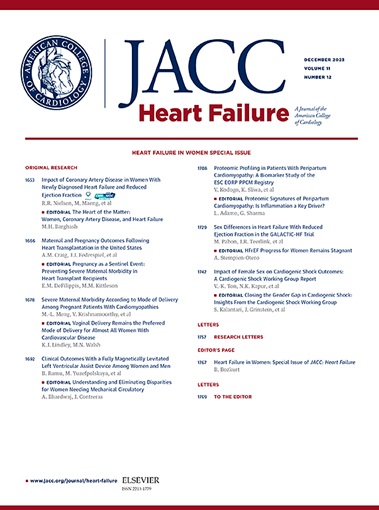Influence of Obesity on Invasive Hemodynamics and Prognosis in Patients With Heart Failure
IF 10.3
1区 医学
Q1 CARDIAC & CARDIOVASCULAR SYSTEMS
引用次数: 0
Abstract
Background
Previous studies have suggested that obesity may cause heart failure with preserved left ventricular ejection and report strong association between body mass index (BMI) and invasive hemodynamics. However, sparse information exists in patients who have heart failure with reduced ejection fraction (HFrEF).
Objectives
This study aimed to investigate associations between BMI and invasive hemodynamics in patients with HFrEF and the influence of obesity on clinical outcomes.
Methods
Referred patients with HFrEF evaluated for advanced heart failure were studied. All patients had right heart catheterization performed. Obesity was defined as BMI ≥30 kg/m2. Clinical events included death, heart transplantation, and durable left ventricular assist device implantation.
Results
The study population comprises 578 patients with a mean age of 52 ± 13 years and BMI of 26 ± 5 kg/m2. Patients with obesity (BMI range: 30-45 kg/m2) counted 126 (22%) and had significantly higher cardiac output and slightly higher central venous pressure compared to patients without obesity. Cardiac output increased by 89 mL/min per 1-U increase in BMI. Vascular resistances were significantly inversely related to BMI. Pulmonary arterial pressure and pulmonary capillary wedge pressure were not associated with BMI. In patients with obesity, symptoms seem to be dissociated from filling pressures and cardiac index, whereas a clear association is observed in patients without. Obesity did not predict survival over a median follow-up of 5.9 years (Q1-Q3: 2.0-10.1 years).
Conclusions
In patients with HFrEF, BMI and CO correlate significantly. Symptoms and hemodynamics appear dissociated in patients with obesity. Finally, survival in patients with obesity did not differ from those without.
肥胖对心衰患者有创血流动力学及预后的影响。
背景:先前的研究表明,肥胖可能导致心力衰竭并保留左心室射血,并报告了身体质量指数(BMI)与侵入性血流动力学之间的密切联系。然而,在心力衰竭伴射血分数降低(HFrEF)的患者中存在稀疏的信息。目的:本研究旨在探讨HFrEF患者BMI与侵袭性血流动力学的关系,以及肥胖对临床结果的影响。方法:对经HFrEF诊断为晚期心力衰竭的转诊患者进行研究。所有患者均行右心导管术。肥胖定义为BMI≥30 kg/m2。临床事件包括死亡、心脏移植和持久的左心室辅助装置植入。结果:研究人群578例,平均年龄52±13岁,BMI为26±5 kg/m2。肥胖患者(BMI范围:30-45 kg/m2) 126例(22%),心输出量明显高于非肥胖患者,中心静脉压略高于非肥胖患者。BMI每增加1 u,心输出量增加89 mL/min。血管阻力与BMI呈显著负相关。肺动脉压和肺毛细血管楔压与BMI无相关性。在肥胖患者中,症状似乎与充盈压力和心脏指数无关,而在非肥胖患者中则观察到明显的关联。肥胖不能预测中位随访5.9年(Q1-Q3: 2.0-10.1年)的生存率。结论:在HFrEF患者中,BMI和CO显著相关。肥胖患者的症状和血流动力学似乎是分离的。最后,肥胖患者与非肥胖患者的生存率并无差异。
本文章由计算机程序翻译,如有差异,请以英文原文为准。
求助全文
约1分钟内获得全文
求助全文
来源期刊

JACC. Heart failure
CARDIAC & CARDIOVASCULAR SYSTEMS-
CiteScore
21.20
自引率
2.30%
发文量
164
期刊介绍:
JACC: Heart Failure publishes crucial findings on the pathophysiology, diagnosis, treatment, and care of heart failure patients. The goal is to enhance understanding through timely scientific communication on disease, clinical trials, outcomes, and therapeutic advances. The Journal fosters interdisciplinary connections with neuroscience, pulmonary medicine, nephrology, electrophysiology, and surgery related to heart failure. It also covers articles on pharmacogenetics, biomarkers, and metabolomics.
 求助内容:
求助内容: 应助结果提醒方式:
应助结果提醒方式:


